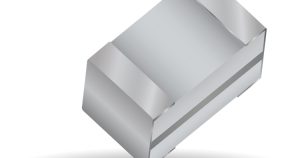The Accu-L Multi-Layer Inductor for High Frequency Applications Written By: Barry N. Breen | Chaim Goldberger | Leonid Talalavsky Abstract: The telecommunications industry today is undergoing changes. The miniaturization of electronic circuits and the use of higher frequencies in radio communication systems such as Cellular Telephones, PCN and GPS places new demands on passive components. High frequency inductors have not kept pace with the demands. AVX has responded to these requirements by putting to market a miniature (0805) high frequency SMD inductor based on thin film technology. This article presents the basic concepts of high frequency inductors and how such low value inductors are measured and characterized. Here, too, there is a lag between the high frequency designer’s need for
RF Microwave / Thin Film
Energy and Power Handling Capabilities of Thin Film and Ceramic Capacitors Written By: Ben Smith Abstract: A continual growth of uncertainty and misconception has been prevalent in determining the power and energy capabilities of both ceramic and silicon capacitors. As today’s systems are subjected to increasingly more stringent requirements, designers are faced with numerous situations where the components that are used dictate design configurations. This paper addresses the concepts associated with a capacitor’s ability to withstand power and energy. Both theoretical and empirical models are developed and used to provide design guidelines.
Dielectric Absorption of Multilayer Organic (MLO™) Capacitors Written By: Edgardo Menendez Abstract: Capacitors with Dielectric Absorption (DA) recover some of their charge even after the capacitor has been fully discharged (see Figure 1). (Ref. 2) It is expressed in percentage and it is based on the measured voltage after discharging and charge recovery divided by the maximum voltage that was originally applied (see Equation 1)…
Benefits of Thin-Film Dielectric Chip Capacitors at VHF, UHF, and Higher Frequencies Written By: Barry Breen | Leonid Talalaevsky | Scot Tripp Abstract: Present and future cellular networks and satellite telecommunications systems demand unique performance characteristics from the SMD capacitors incorporated into their designs. To meet these requirements, single layer surface mount capacitors have been developed on the basis of thin film technologies. The capacitor’s single layer thin film construction provides several major performance advantages relative to multilayer chips. These are much improved Q (low ESR), consistent and repeatable Q/ESR/Ceff/SRF parameters, superior power capability, no secondary resonances up to a frequency of 40GHz and very tight tolerance on capacitance value. By virtue of these characteristics and excellent mechanical features, this
Accu-P® Thin-Film Capacitors Act as Band Reject Filters Written By: Avital Yaish Abstract: AVX Accu-P® capacitors exhibit excellent resonance stability which makes them ideal for Band Reject Filters, whereas Ceramic capacitors are unsuitable due to their wide SRF scatter.
A Review of High Frequency Passive Component Technologies (Thin-Film, Thick-Film, Discretes & PMC) for RF Design Applications Written By: Chris Reynolds Abstract: This article traces the evolution of these technologies and discusses the benefits and trade offs for each. The current level of RF component integration available in existing discrete package sizes is discussed, along with trends to tighter tolerance and ultra-stable parametric performance. The article concludes with an update on the emergence of higher levels of integration into passive component networks, and how this is now enabling engineers to optimize their RF designs. A version of this article was published in RF Design, August 2005.
A Performance Comparison of Thin-Film and Wirewound Inductors Written By: Rom Demcko Abstract: This article evaluates the performance differences of thin-film and wirewound inductors. It looks at the properties of both technologies and evaluates the benefits particularly in wireless applications. A version of this article was previously published in Wireless Design and Development, May 2006.
Thin Film Filter Design and Technology Written By: George Korony Abstract: When specifying filter for a design, the admissible insertion loss and frequency range in the pass-band, the required attenuation and frequency ranges in the forbidden-bands, are the most important characteristics of filters. Several other important parameters are also required to define a filter, including functional parameters as input output impedances, power handling capabilities, and reliability requirements, as well as physical requirements such as dimensions, input-output type (wire-bond, SMT, BGA), and encapsulation. Other conditions may be imposed by special applications (space, automotive, medical)





